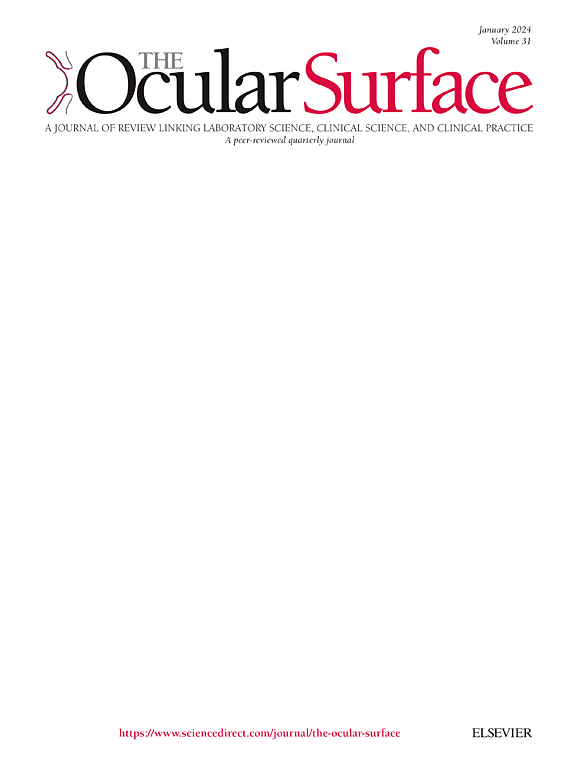Ultrasonography assessments of meibomian gland as a noninvasive method of detecting changes in morphology
IF 5.6
1区 医学
Q1 OPHTHALMOLOGY
引用次数: 0
Abstract
Purpose
We employed 24 MHz ultrasonography to evaluate the morphological features of meibomian glands (MGs) and compared the ultrasonic differences in morphology between healthy volunteers and meibomian gland dysfunction (MGD) patients.
Methods
24 MHz ultrasound examinations on both the upper and lower eyelids of healthy volunteers and patients with MGD, using transverse and longitudinal sections. The reproducibility of ultrasonographic findings for the MG was evaluated, and a comparison of morphological characteristics at different examination sites between the two groups was made.
Results
Among 89 participants, 24 were healthy volunteers and 65 had MGD. The cross-sectional ultrasound findings showed well-organized punctate hyperechoic ducts within the tarsal plate, surrounded by hypoechoic acinar formations, which were further classified based on the extent of MG involvement into three categories: normal, ≤50 % involvement, and >50 % involvement. Additionally, a typical longitudinal ultrasound appearance of a MG consisted of a thin band-like hypoechoic structure (acinar) with uniform thickness accompanied by an arc-shaped linear hyperechoic duct in its middle region. Furthermore, seven abnormal longitudinal ultrasound manifestations were categorized as distortion, ectasia, central duct truncation, cyst formation, structureless appearance, complete disappearance or other findings. The intra- and inter-observer agreement for those categories was found to be high (ICC>0.6). MGD patients exhibited a higher likelihood of overall MG involvement or abnormal ultrasound findings, particularly in relation to the middle part of the upper eyelid.
Conclusion
The present study has developed an initial classification method to identify abnormalities in MG morphology using 24 MHz ultrasound in MGD patients.
超声评估睑板腺作为一种无创检测形态学变化的方法
采用24 MHz超声对睑板腺(mg)的形态学特征进行了评价,并比较了健康志愿者与睑板腺功能障碍(MGD)患者的超声形态学差异。
本文章由计算机程序翻译,如有差异,请以英文原文为准。
求助全文
约1分钟内获得全文
求助全文
来源期刊

Ocular Surface
医学-眼科学
CiteScore
11.60
自引率
14.10%
发文量
97
审稿时长
39 days
期刊介绍:
The Ocular Surface, a quarterly, a peer-reviewed journal, is an authoritative resource that integrates and interprets major findings in diverse fields related to the ocular surface, including ophthalmology, optometry, genetics, molecular biology, pharmacology, immunology, infectious disease, and epidemiology. Its critical review articles cover the most current knowledge on medical and surgical management of ocular surface pathology, new understandings of ocular surface physiology, the meaning of recent discoveries on how the ocular surface responds to injury and disease, and updates on drug and device development. The journal also publishes select original research reports and articles describing cutting-edge techniques and technology in the field.
Benefits to authors
We also provide many author benefits, such as free PDFs, a liberal copyright policy, special discounts on Elsevier publications and much more. Please click here for more information on our author services.
Please see our Guide for Authors for information on article submission. If you require any further information or help, please visit our Support Center
 求助内容:
求助内容: 应助结果提醒方式:
应助结果提醒方式:


